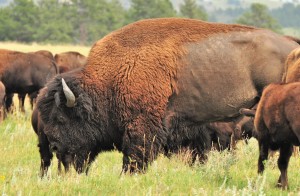Photography courtesy of Lowell Washburn, all rights reserved.
Dueling Bison Provide Late Summer Drama
Late summer is one of my favorite times for visiting the Black Hills of western South Dakota. For the American bison, it’s the peak of the annual breeding season and mature bulls are on the scrap. With blood running hotter than the prairie sun, love struck prime-of-life-bulls are currently regarding every other male as a potential rival. As a result, the western grasslands have become a tinder box of irrational emotion. When bulls cross trails, tempers flare. Battles erupt.
The age-old duel begins as bellowing bulls square off. Shaking their massive black horned heads, the giant mammals signify their intentions by vigorously pawing the earth, sending plumes of dust high above their six-foot shoulders. Tensions mount quickly; and saber-rattling gives way to violence as the bulls make their move. Following a quick burst of speed, the shaggy two thousand-pound beasts come together in a ground shaking head to head collision. The scene brings new meaning to the term “head butt”.
In an exhilarating exhibition of sheer power, the bulls utilize every ounce of strength their muscular frames can muster. With neither willing to give ground, the combatants twist, turn, shove, and gouge. Horns clash, hooves churn for traction, chunks of sod fly high. The drama provides a sight and sound that leaves human observers in awe.
Some battles are brief; others may rage for several minutes. But sooner or later, the contest will end. Driving his defeated rival from the field, a bruised but victorious bull takes his place among a group of grazing cows. Surveying an endless panorama of browning grassland, he has become the undisputed ruler of a prairie empire — at least for the moment.
Although South Dakota is my favorite backdrop for viewing bison in a natural setting – I’ve been watching them here since 1958 – additional opportunities exist all across America’s western grasslands. Yellowstone and Glacier National Parks are among the most popular locations. Closer to home, this iconic species can be observed at the Neal Smith National Wildlife Refuge, where bison still roam the prairies of central Iowa.
LW



 Susan Judkins Josten
Susan Judkins Josten Rudi Roeslein
Rudi Roeslein Elyssa McFarland
Elyssa McFarland Mark Langgin
Mark Langgin Adam Janke
Adam Janke Joe Henry
Joe Henry Sue Wilkinson
Sue Wilkinson Tom Cope
Tom Cope Kristin Ashenbrenner
Kristin Ashenbrenner Joe Wilkinson
Joe Wilkinson Dr. Tammy Mildenstein
Dr. Tammy Mildenstein Sean McMahon
Sean McMahon